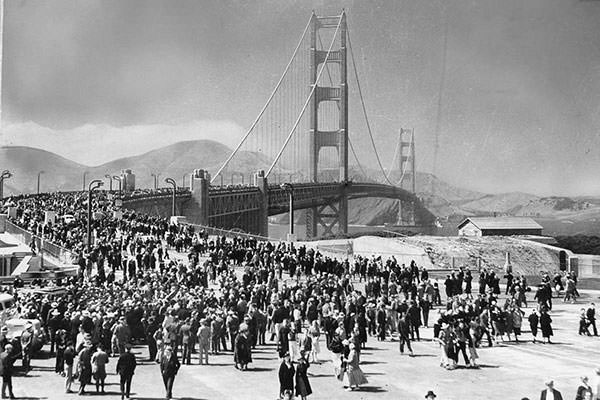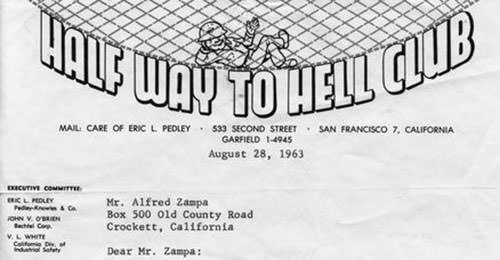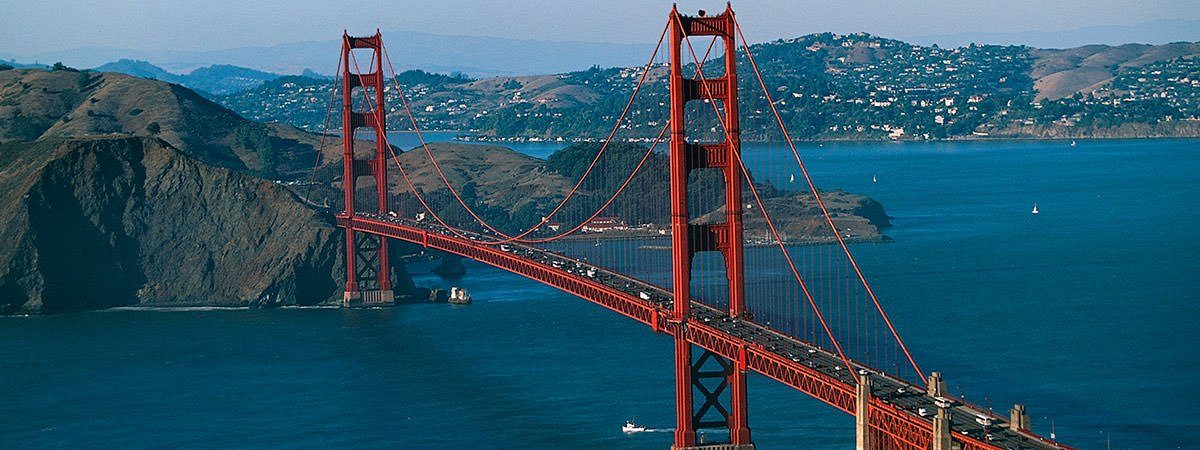The Golden Gate Bridge is an iconic landmark in San Francisco, United States. It is a 1.7 km long suspension bridge connecting the city of San Francisco to Marin County in California, spanning across the Golden Gate strait. First proposed way back in 1872, the construction of the Golden Gate Bridge began on January 5, 1933, under the supervision of a Chicago-based engineer named Joseph Strauss. It was completed in four years and opened for vehicles on May 28, 1937.
At the time its construction was completed, the Golden Gate Bridge was the longest as well as the tallest suspension bridge in the world. Today, about 112,000 vehicles cross the Golden Gate Bridge every day, and it has become one of the most recognized bridges in the world and pop culture. The American Society of Civil Engineers has in fact named it as one of the Wonders of the Modern World. Moreover, it is said to be the “most photographed bridge in the world.” Know more about the history, construction and statistics of the Golden Gate Bridge through these 10 interesting facts.
#1 THE NAME OF THE BRIDGE MAY BE TRACED TO A REPUBLICAN PRESIDENTIAL CANDIDATE
The name of the Golden Gate Bridge has nothing to do with its color. The bridge is named after the Golden Gate, a strait on the west coast of North America that connects San Francisco Bay to the Pacific Ocean. The person who gave this name to this strait was John Charles Fremont, an American explorer, military officer and politician who, in 1856, would become the first Republican candidate for President of the United States.

Fremont gave this name to the strait because it reminded him of another beautiful landlocked harbor, the Golden Horn of the Bosporus in Constantinople, now Istanbul. Fremont in fact used a Greek term for the strait, ‘Chrysopylae’ or ‘Golden Gate’. He also went on to comment in his memoirs that the strait was “a golden gate to trade with the Orient”. By the early 20th century, the Golden Gate became a well established name for the strait and thus the bridge that was built across it was named the Golden Gate Bridge.
#2 JOSEPH B. STRAUSS WAS THE CHIEF ENGINEER OF THE GOLDEN GATE BRIDGE
Before the Golden Gate Bridge was built, the only practical way to travel from San Francisco to Marin County was through a boat. As early as 1820, a ferry service began to serve the purpose but many wanted a bridge to make the travel easy. San Francisco was, in fact, the largest American city still served primarily by ferry boats. However, it was thought by many that it was an impossible task to construct a bridge at the location as experts believed that ferocious winds and blinding fogs in the region would prevent construction and operation.

The project for a bridge to connect San Francisco to Marin County was first proposed in 1872 when railroad executive Charles Chocker made a presentation to the Marin County Board of Supervisors. However, it was in 1919 that the San Francisco Board of Supervisors asked the engineer of the city, Michael O’Shaughnessy, to determine the feasibility of such a bridge. Chicago-based engineer, Joseph B. Strauss, was finally assigned the monumental task and he promised to finish the bridge at a modest cost of $17 million (equivalent to $391 million today) when others estimated that it would cost $100 million (equivalent to $2.3 billion today).
#3 SEVERAL PEOPLE ARE RESPONSIBLE FOR ITS FAMED DESIGN
In June 1921, Strauss submitted designs of a cantilever bridge on either side of the strait with a central suspension. However, local authorities rejected it and asked him to alter his plans by consulting other project experts. The following year, Strauss hired structural engineer Charles Alton Ellis to supervise the design; and in 1925, he brought in suspension bridge engineer Leon Moisseiff and architect Irving Morrow. Finally, due to recent strides in the field of metallurgy, a suspension bridge design was considered the most financially sound as well efficient option.

It was Ellis, who elaborated on the theories of Moisseiff and applied them in the famed design of the bridge. Ellis was also responsible for the technical and theoretical work of the bridge. Strauss later fired him, but because of his passion for the project and lack of availability of work elsewhere, Ellis continued his efforts towards the design of the bridge. Irving Morrow supervised the design of the bridge towers; lighting scheme; color of the bridge; and art deco elements like railings, tower decorations, walkways and streetlights.
#4 THE CONSTRUCTION OF THE BRIDGE FACED OPPOSITION FROM MANY SOURCES
The journey of the Golden Gate Bridge from initial designs to actual construction faced opposition from many sources, including the Southern Pacific Railroad, the US Navy and the US Department of War. Southern Pacific Railroad, owners of a majority stake in the ferry fleet which took commuters from San Francisco and Marin County, saw the bridge as competition and filed a lawsuit against the project. This led to a mass boycott of its services. The US Navy was concerned that the sabotage to the bridge could block access to one of the principal harbors and feared ship collisions. The US Department of War, which owned the land on both sides of the Strait, was worried that the bridge would interfere with ship traffic.
Moreover, environmentalists opposed the bridge as they believed that it would mar the beauty of the strait. It took several favorable court rulings, two Federal hearings and an enabling act from the State legislature before the bridge was finally approved. Moreover, it was guaranteed that local workers would be favored for construction jobs to meet the demands of the Unions. The US War Department granted a temporary construction permit on December 24, 1924; and the final construction permit on August 11, 1930.
#5 THE GOLDEN GATE BRIDGE OPENED ON MAY 27, 1937
The construction of the Golden Gate Bridge, under the supervision of chief engineer Joseph B. Strauss, officially began on January 5, 1933. McClintic-Marshall Construction Co. carried out the construction project. The construction of the bridge was completed ahead of schedule taking around four years. The cost of construction of the bridge was $35 million (1.2 billion dollars today). This was $1.3 million under budget.

The Golden Gate Bridge was opened for the first time to pedestrians on May 27, 1937. By the time it opened at 6 am, around 18,000 people were waiting for their chance to walk on it. Over the course of the day of its inauguration, an estimated 15,000 people crossed the bridge each hour paying 25 cents each. The next day, President Franklin Roosevelt pressed a golden button in Washington, D.C., officially opening the bridge for automobile traffic. Vehicular traffic started on the bridge at noon, May 28, 1937.
#6 HALF WAY TO HELL CLUB WAS FORMED DURING THE CONSTRUCTION OF THE BRIDGE
As deaths during construction was a common occurrence in those times, Joseph Strauss insisted on safety precautions including a safety net that was slung beneath the bridge. Though it cost $130,000, it saved the lives of 19 people. These 19 people, who fell from the Golden Gate Bridge during its construction in 1936 and 1937 and were eventually saved by the safety net, formed a club known as the ‘Half Way to Hell’ Club.

According to the unofficial spokesman of the club, Al Zampa, when a man fell to his death from a bridge it was said “he’s gone to hell.” However, as these men were saved by the net, they were said to have fallen only “half way to hell.” Because of the safety precautions taken by Strauss, during the course construction of the bridge, only eleven men lost their lives, which was unheard of for a construction project of this stature. While only one man had lost his life until 1937, it was February 17, 1937, when tragedy struck ten men as a 5-ton platform broke from the bridge and fell through the safety net.
#7 IT WAS THE LONGEST AND THE TALLEST SUSPENSION BRIDGE IN THE WORLD
With a length of 1300m (4200ft), the Golden Gate Bridge had the longest suspension bridge main span in the world from 1933 to 1964. Since then, fifteen bridges have surpassed its main span length. At present, it is the second-longest suspension bridge in the United States, after New York City’s Verrazano-Narrows Bridge. Moreover, it had the world’s tallest towers on a suspension bridge standing at 227 m (746 feet) above the water. However, in 1993, the Mezcala Bridge in Mexico surpassed its record. When it comes to clearance above high water, the bridge has an average of 67 m (220 ft.).

The Golden Gate Bridge has 250 pairs of vertical suspender ropes, which are fixed to two main cables. The foundations of these cables are set in concrete at each end, passing over the two main towers of the bridge, which have 60,000 rivets each. Galvanized steel wire, which was used to construct these two main cables has an estimated length of 130,000 km (80,000 miles). Moreover, the Golden Gate Bridge is said to be the “most photographed bridge in the world.”
#8 THE GOLDEN GATE BRIDGE IS PAINTED INTERNATIONAL ORANGE
At the time the bridge was constructed, most bridges were gray, silver or black. However, the Golden Gate Bridge was painted International Orange and since then its color has become a striking as well as iconic part of the bridge. The International Orange color was a brainchild of Irving Morrow. It was approved over US Navy’s recommendation for it to be painted with black and yellow stripes so that passing ships could spot the bridge easily.

Morrow in his ‘The Golden Gate Bridge- Report on Color and Lighting’ spoke of the bridge as ‘one of the greatest monuments of all time’ because of ‘its unprecedented size and scale with its grace of form and independence of conception.’ According to him, this called for a ‘unique and unconventional treatment from every point of view,’ including its color. He chose ‘International Orange’ after noticing striking reddish-orange primer painted on some of the steel. He further added that International orange was an ideal complement to the golden and green hills, the blue water and sky, and the gray fog.
#9 IT FLATTENED ON ITS 50TH ANNIVERSARY
On its 50th anniversary, in May 1987, the Golden Gate Bridge allowed only pedestrians to cross it and discontinued the automobile traffic. Officials had expected the headcount to be 50,000, but around 750,000 to 1,000,000 people showed up. The bridge soon became congested and overloaded with 300,000 people due to a lack of effective crowd control. The huge number of people caused the center of the bridge to flatten under the excessive load. While later engineers deemed the bridge as still ‘safe’ and not in any danger of collapsing, no such event has been allowed since then without crowd control. In fact, for its 75th anniversary, bearing 9/11 and security concerns in mind, no such pedestrian-only event was allowed.

#10 THE GOLDEN GATE BRIDGE IS INFAMOUS AS A SUICIDE SPOT
Amid the architectural glory, the Golden Gate Bridge is also infamous as a suicide spot. It is reportedly the second-most used suicide bridge in the world after China’s Nanjing Yangtze River Bridge. More than 1,600 people have committed suicide by jumping from the bridge, dying either from impact trauma or drowning and hypothermia. The fall from the bridge lasts 4 seconds and the person hits the water at a speed of 120 km/hr. (75 miles/hr.) falling 75 m (245 ft.). The fatality rate of people jumping from the bridge is 98%. As of 2013, only 34 people have survived after jumping. The first person to commit suicide on the bridge was Harold B. Wobber in August 1937. Many measures have been taken including telephone lines helping in counseling set along the bridge; and provisions for a safety net as a precaution. The measures have been successful to some extent. In 2013, 118 potential jumpers were talked down from their attempt and did not jump.

